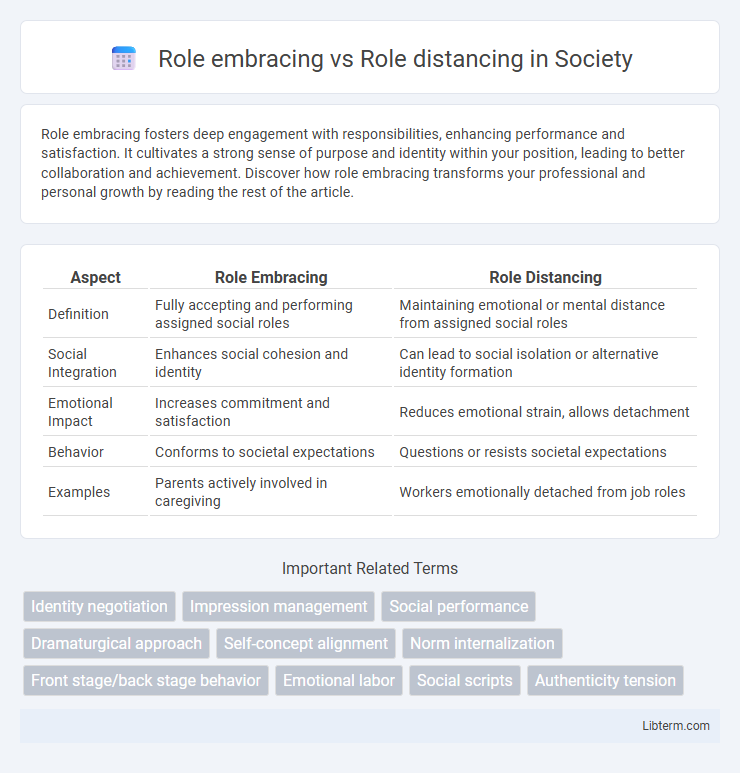Role embracing fosters deep engagement with responsibilities, enhancing performance and satisfaction. It cultivates a strong sense of purpose and identity within your position, leading to better collaboration and achievement. Discover how role embracing transforms your professional and personal growth by reading the rest of the article.
Table of Comparison
| Aspect | Role Embracing | Role Distancing |
|---|---|---|
| Definition | Fully accepting and performing assigned social roles | Maintaining emotional or mental distance from assigned social roles |
| Social Integration | Enhances social cohesion and identity | Can lead to social isolation or alternative identity formation |
| Emotional Impact | Increases commitment and satisfaction | Reduces emotional strain, allows detachment |
| Behavior | Conforms to societal expectations | Questions or resists societal expectations |
| Examples | Parents actively involved in caregiving | Workers emotionally detached from job roles |
Understanding Role Embracing and Role Distancing
Role embracing involves fully adopting the responsibilities, behaviors, and identity associated with a specific role, leading to increased commitment and authenticity in performance. Role distancing occurs when individuals consciously detach or separate from their assigned role, often to maintain personal autonomy or avoid negative judgments. Understanding role embracing and role distancing is crucial for analyzing how people navigate social expectations and manage their self-presentation in various contexts.
The Psychology Behind Social Roles
Role embracing involves fully internalizing and aligning with social expectations, leading to enhanced identity coherence and psychological well-being. Role distancing occurs when individuals deliberately detach from prescribed roles to maintain autonomy and resist social pressures. Psychological theories highlight that balancing role embracing and distancing is crucial for adaptive self-concept management and social functioning.
Factors Influencing Role Embracement
Factors influencing role embracement include organizational culture, individual self-concept, and perceived role clarity. Supportive leadership and positive feedback reinforce commitment to role expectations, enhancing role identification and engagement. Personal values aligning with role demands and socialization processes within teams also significantly affect the degree to which individuals embrace their roles.
Motivations for Role Distancing
Role distancing occurs when individuals deliberately detach themselves from their social roles to avoid stigma or negative judgments associated with those roles. Motivations for role distancing often include a desire to maintain personal identity, protect self-esteem, and navigate conflicts between societal expectations and personal values. This behavior helps individuals manage social impressions and reduces the psychological burden of roles perceived as undesirable or limiting.
Impact of Role Adoption on Identity
Role embracing enhances personal identity by aligning an individual's self-concept with social expectations and responsibilities, fostering a coherent sense of self and social belonging. In contrast, role distancing creates psychological separation from assigned roles, which can lead to identity fragmentation but also allows for greater self-expression and resistance to social pressures. The impact of role adoption on identity hinges on the degree to which individuals internalize or reject roles, shaping their self-perception and social interactions dynamically.
Role Distancing in Professional Settings
Role distancing in professional settings involves employees intentionally creating psychological or physical space from their job roles to maintain personal identity and emotional well-being. This behavior often manifests through reduced emotional involvement, symbolic gestures, or verbal cues that signal detachment from work responsibilities. Understanding role distancing is crucial for organizations aiming to improve employee engagement, job satisfaction, and overall workplace morale.
Cultural Perspectives on Social Roles
Role embracing involves individuals fully accepting and performing social roles expected by their cultural context, reinforcing societal norms and group identity. Role distancing occurs when individuals express detachment or reluctance toward these roles, often reflecting resistance to cultural expectations or personal identity conflicts. Cultural perspectives shape these behaviors by defining the significance, flexibility, and consequences associated with conforming to or deviating from social roles within a given society.
Benefits and Challenges of Role Embracing
Role embracing enhances commitment and identity alignment, fostering increased motivation and job satisfaction through deep engagement with responsibilities. However, it may lead to challenges such as potential role overload and reduced flexibility, as individuals might find it difficult to detach from their assigned roles. Balancing strong role identification with adaptive boundaries is crucial to maximize benefits while mitigating stress and burnout.
Navigating Role Conflict and Ambiguity
Role embracing involves actively accepting and internalizing the expectations and responsibilities associated with a role, which can facilitate clearer identity and reduced stress in situations of role conflict and ambiguity. Role distancing, on the other hand, allows individuals to psychologically detach from certain roles, providing flexibility to manage conflicting demands and minimize emotional strain. Effective navigation of role conflict and ambiguity often requires a dynamic balance between embracing roles to fulfill obligations and distancing from roles to protect personal well-being.
Strategies for Balancing Multiple Roles
Role embracing involves fully engaging with and accepting multiple roles, leveraging strategies like effective time management and prioritization to maintain balance. Role distancing entails creating psychological or physical boundaries to reduce the impact of conflicting demands from different roles. Balancing multiple roles requires adaptive approaches such as role segmentation, seeking social support, and flexible role negotiation to optimize performance and well-being.
Role embracing Infographic

 libterm.com
libterm.com